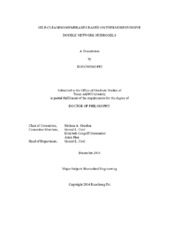| dc.description.abstract | By providing continuous glucose monitoring, a subcutaneously implanted glucose sensor would greatly improve the quality of life for diabetics. However, implantation of a sensor triggers the host response in which proteins and cells attach and accumulate onto the sensor membrane surface. This membrane biofouling severely limits sensor lifetime and accuracy by restricting glucose diffusion. Whereas attempts to reduce membrane biofouling have mostly relied on passivation approaches, we have designed “self-cleaning” membranes whose surfaces actively detach adhered proteins and cells upon thermal cycling. Thermoresponsive poly(N-isopropylacrylamide) (PNIPAAm) single network (SN) hydrogels deswell and reswell, respectively, when heated above and cooled below their volume phase transition temperature (VPTT). A self-cleaning PNIPAAm membrane would ideally be typically swollen (OFF-state) to facilitate glucose diffusion to the embedded sensor or sensing material. However, when transdermally heated above the VPTT, the membrane would reversibly switch to the deswollen state. This cyclical process would cause the active detachment of proteins and cells, thereby cleaning the surface to restore glucose diffusion. Double network (DN) designs, based on asymmetrically crosslinked, interpenetrating PNIPAAm networks, as well as considerations of membrane geometry and size were utilized to achieve the functional requirements of a self-cleaning membrane.
This research was comprised of four major studies. In the first study, thermoresponsive PNIPAAm DN nanocomposite hydrogels containing inorganic polysiloxane nanoparticles were prepared. Inorganic, hydrophobic polysiloxane nanoparticles (~50 nm and ~200 nm average diameters) were introduced during formation of the 1st or 2nd network of the PNIPAAm DN hydrogel.
In the second study, thermoresponsive PNIPAAm DN hydrogels were prepared with an electrostatic comonomer (2-acrylamido-2-methylpropanesulfonic acid, AMPS). The negatively charged AMPS was incorporated at varying levels (0-75 wt% based on NIPAAm weight) during formation of the 1st network but was excluded from the 2nd network to retain the thermoresponsive behavior.
In the third study, the combined impact of a PNIPAAm DN design and reduction of hydrogel size to the micron-scale on thermosensitivity and cell release efficacy was evaluated. PNIPAAm SN and DN hydrogels were prepared as 1.5 mm-thick planar slabs as well as micropillar arrays.
The final aspect of this work was focused on evaluating the charged membrane design in terms of functional requirements essential to a final implanted glucose biosensor. This study paralleled previous efforts to likewise characterize a particular DN nanocomposite membrane. | en |


